Page 73 of 240
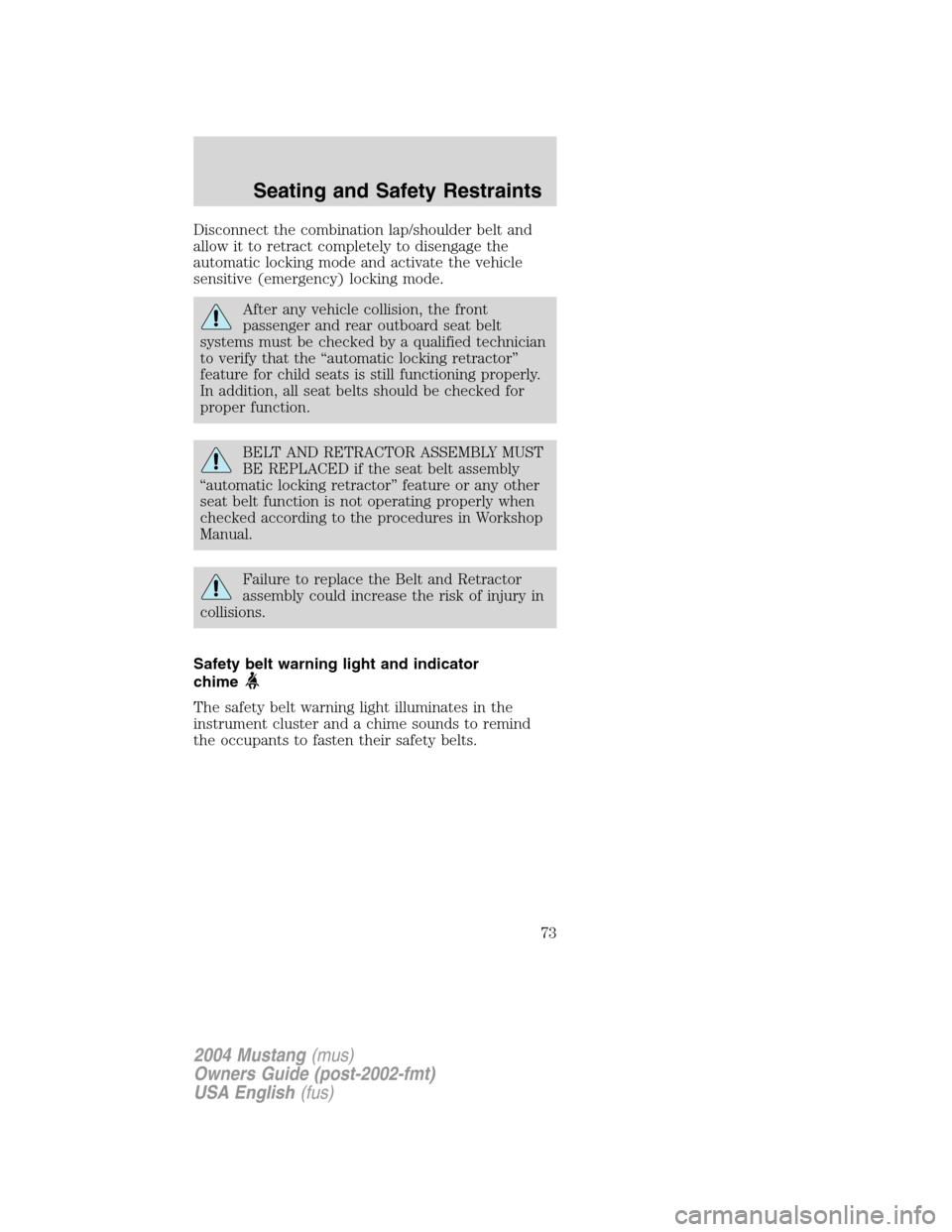
Disconnect the combination lap/shoulder belt and
allow it to retract completely to disengage the
automatic locking mode and activate the vehicle
sensitive (emergency) locking mode.
After any vehicle collision, the front
passenger and rear outboard seat belt
systems must be checked by a qualified technician
to verify that the“automatic locking retractor”
feature for child seats is still functioning properly.
In addition, all seat belts should be checked for
proper function.
BELT AND RETRACTOR ASSEMBLY MUST
BE REPLACED if the seat belt assembly
“automatic locking retractor”feature or any other
seat belt function is not operating properly when
checked according to the procedures in Workshop
Manual.
Failure to replace the Belt and Retractor
assembly could increase the risk of injury in
collisions.
Safety belt warning light and indicator
chime
The safety belt warning light illuminates in the
instrument cluster and a chime sounds to remind
the occupants to fasten their safety belts.
2004 Mustang(mus)
Owners Guide (post-2002-fmt)
USA English(fus)
Seating and Safety Restraints
73
Page 84 of 240
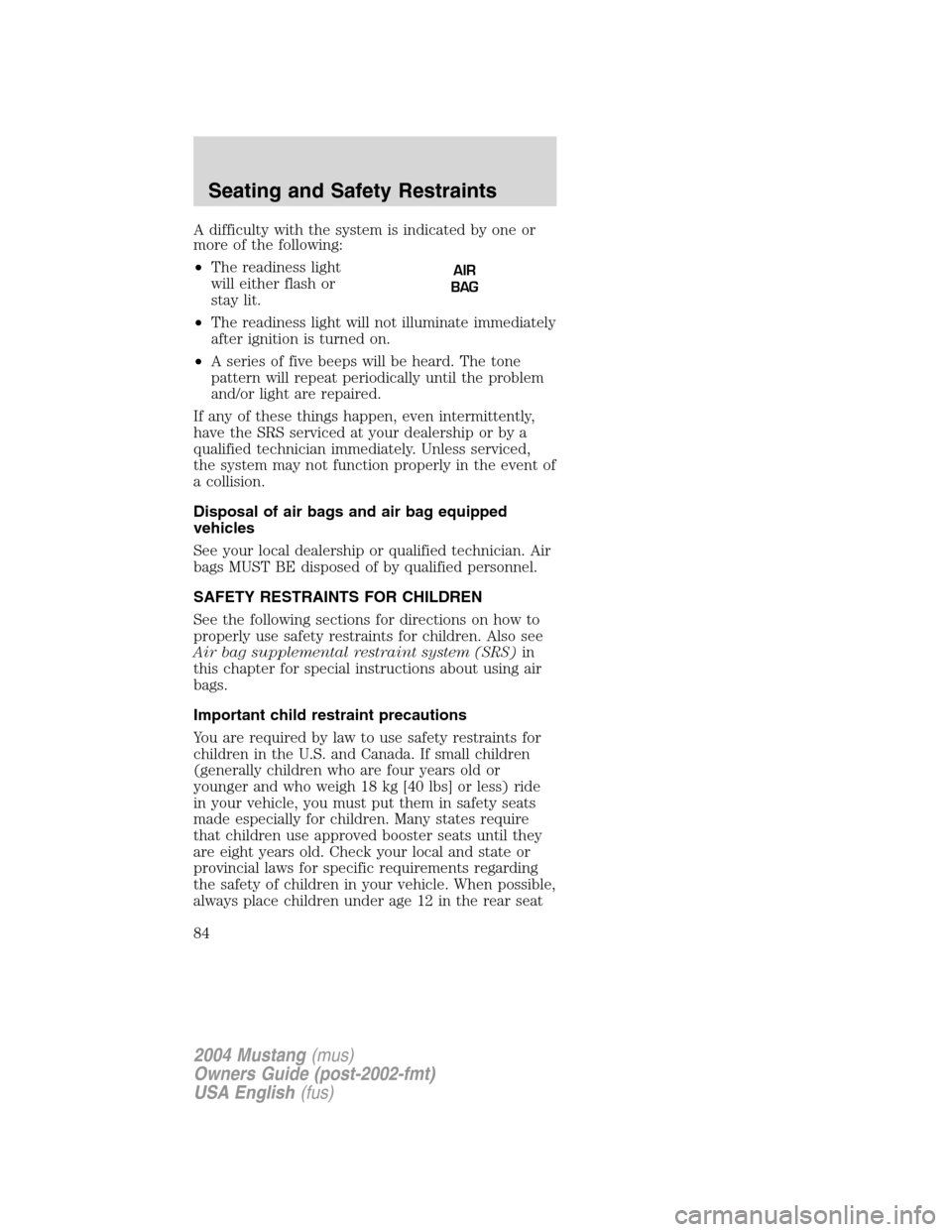
A difficulty with the system is indicated by one or
more of the following:
•The readiness light
will either flash or
stay lit.
•The readiness light will not illuminate immediately
after ignition is turned on.
•A series of five beeps will be heard. The tone
pattern will repeat periodically until the problem
and/or light are repaired.
If any of these things happen, even intermittently,
have the SRS serviced at your dealership or by a
qualified technician immediately. Unless serviced,
the system may not function properly in the event of
a collision.
Disposal of air bags and air bag equipped
vehicles
See your local dealership or qualified technician. Air
bags MUST BE disposed of by qualified personnel.
SAFETY RESTRAINTS FOR CHILDREN
See the following sections for directions on how to
properly use safety restraints for children. Also see
Air bag supplemental restraint system (SRS)in
this chapter for special instructions about using air
bags.
Important child restraint precautions
You are required by law to use safety restraints for
children in the U.S. and Canada. If small children
(generally children who are four years old or
younger and who weigh 18 kg [40 lbs] or less) ride
in your vehicle, you must put them in safety seats
made especially for children. Many states require
that children use approved booster seats until they
are eight years old. Check your local and state or
provincial laws for specific requirements regarding
the safety of children in your vehicle. When possible,
always place children under age 12 in the rear seat
AIR
BAG
2004 Mustang(mus)
Owners Guide (post-2002-fmt)
USA English(fus)
Seating and Safety Restraints
84
Page 85 of 240
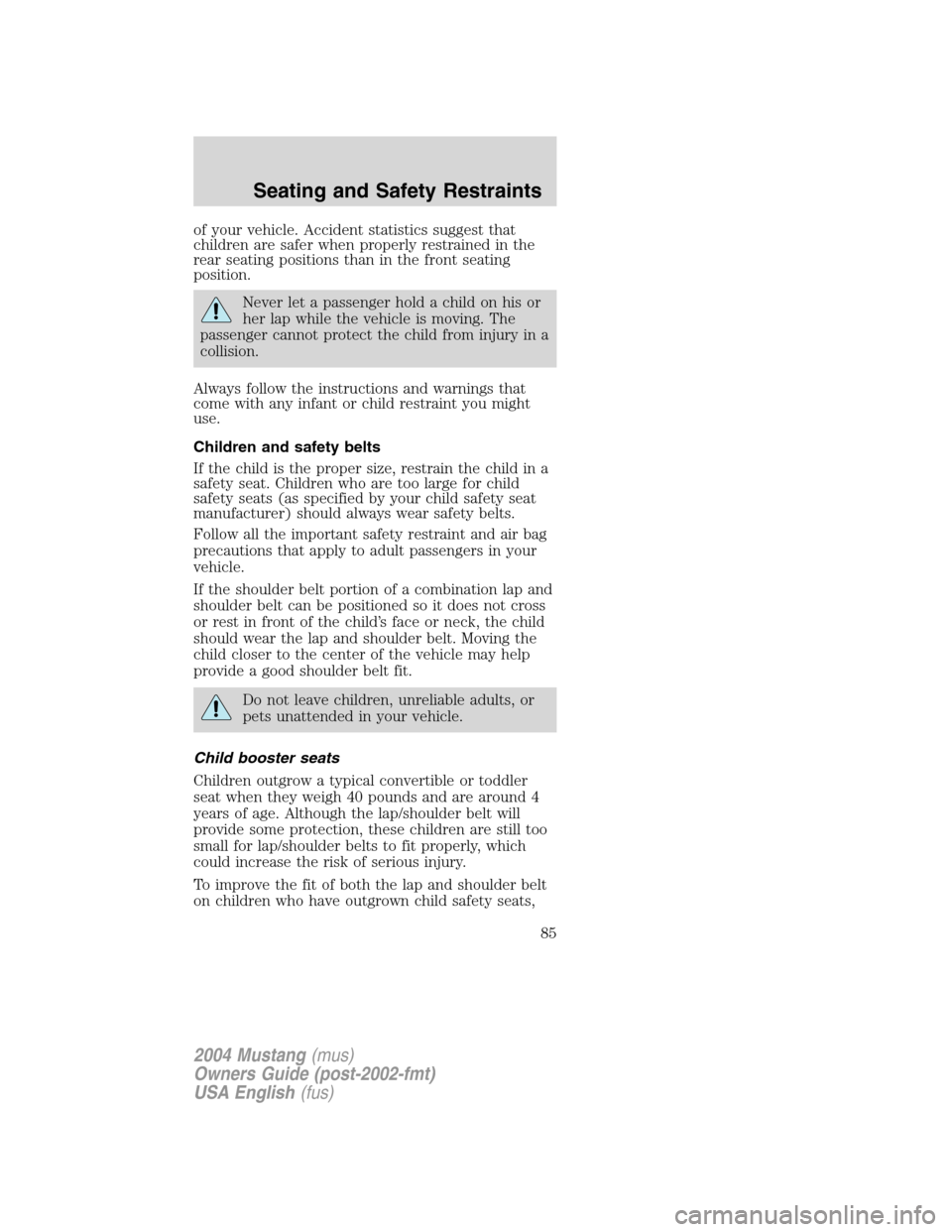
of your vehicle. Accident statistics suggest that
children are safer when properly restrained in the
rear seating positions than in the front seating
position.
Never let a passenger hold a child on his or
her lap while the vehicle is moving. The
passenger cannot protect the child from injury in a
collision.
Always follow the instructions and warnings that
come with any infant or child restraint you might
use.
Children and safety belts
If the child is the proper size, restrain the child in a
safety seat. Children who are too large for child
safety seats (as specified by your child safety seat
manufacturer) should always wear safety belts.
Follow all the important safety restraint and air bag
precautions that apply to adult passengers in your
vehicle.
If the shoulder belt portion of a combination lap and
shoulder belt can be positioned so it does not cross
or rest in front of the child’s face or neck, the child
should wear the lap and shoulder belt. Moving the
child closer to the center of the vehicle may help
provide a good shoulder belt fit.
Do not leave children, unreliable adults, or
pets unattended in your vehicle.
Child booster seats
Children outgrow a typical convertible or toddler
seat when they weigh 40 pounds and are around 4
years of age. Although the lap/shoulder belt will
provide some protection, these children are still too
small for lap/shoulder belts to fit properly, which
could increase the risk of serious injury.
To improve the fit of both the lap and shoulder belt
on children who have outgrown child safety seats,
2004 Mustang(mus)
Owners Guide (post-2002-fmt)
USA English(fus)
Seating and Safety Restraints
85
Page 86 of 240
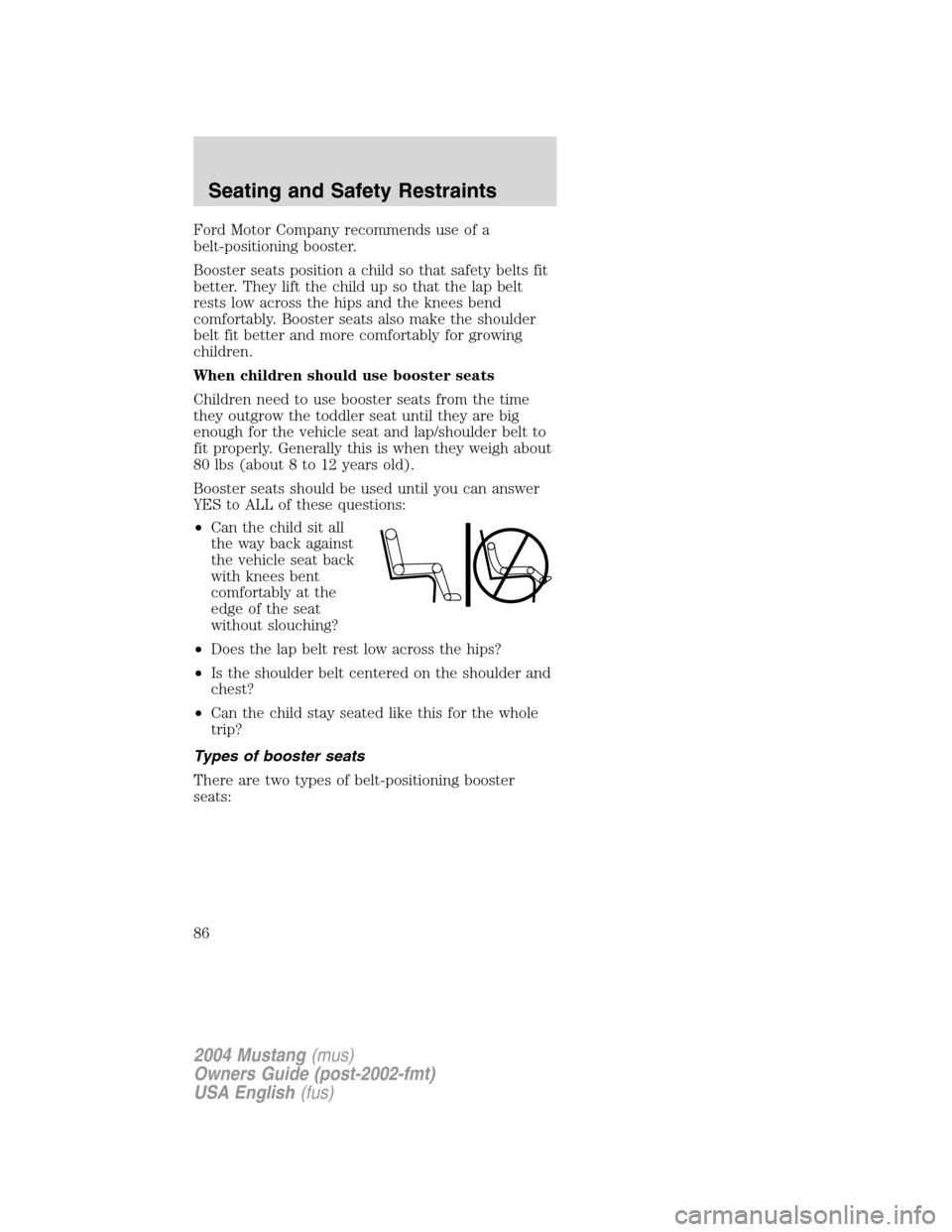
Ford Motor Company recommends use of a
belt-positioning booster.
Booster seats position a child so that safety belts fit
better. They lift the child up so that the lap belt
rests low across the hips and the knees bend
comfortably. Booster seats also make the shoulder
belt fit better and more comfortably for growing
children.
When children should use booster seats
Children need to use booster seats from the time
they outgrow the toddler seat until they are big
enough for the vehicle seat and lap/shoulder belt to
fit properly. Generally this is when they weigh about
80 lbs (about 8 to 12 years old).
Booster seats should be used until you can answer
YES to ALL of these questions:
•Can the child sit all
the way back against
the vehicle seat back
with knees bent
comfortably at the
edge of the seat
without slouching?
•Does the lap belt rest low across the hips?
•Is the shoulder belt centered on the shoulder and
chest?
•Can the child stay seated like this for the whole
trip?
Types of booster seats
There are two types of belt-positioning booster
seats:
2004 Mustang(mus)
Owners Guide (post-2002-fmt)
USA English(fus)
Seating and Safety Restraints
86
Page 88 of 240
Follow all instructions provided by the
manufacturer of the booster seat.
Never put the shoulder belt under a child’s
arm or behind the back because it
eliminates the protection for the upper part of the
body and may increase the risk of injury or death
in a collision.
Never use pillows, books, or towels to boost
a child. They can slide around and increase
the likelihood of injury or death in a collision.
SAFETY SEATS FOR CHILDREN
Child and infant or child safety seats
Use a safety seat that is recommended for the size
and weight of the child. Carefully follow all of the
manufacturer’s instructions with the safety seat you
put in your vehicle. If you do not install and use the
safety seat properly, the child may be injured in a
sudden stop or collision.
When installing a child safety seat:
2004 Mustang(mus)
Owners Guide (post-2002-fmt)
USA English(fus)
Seating and Safety Restraints
88
Page 89 of 240
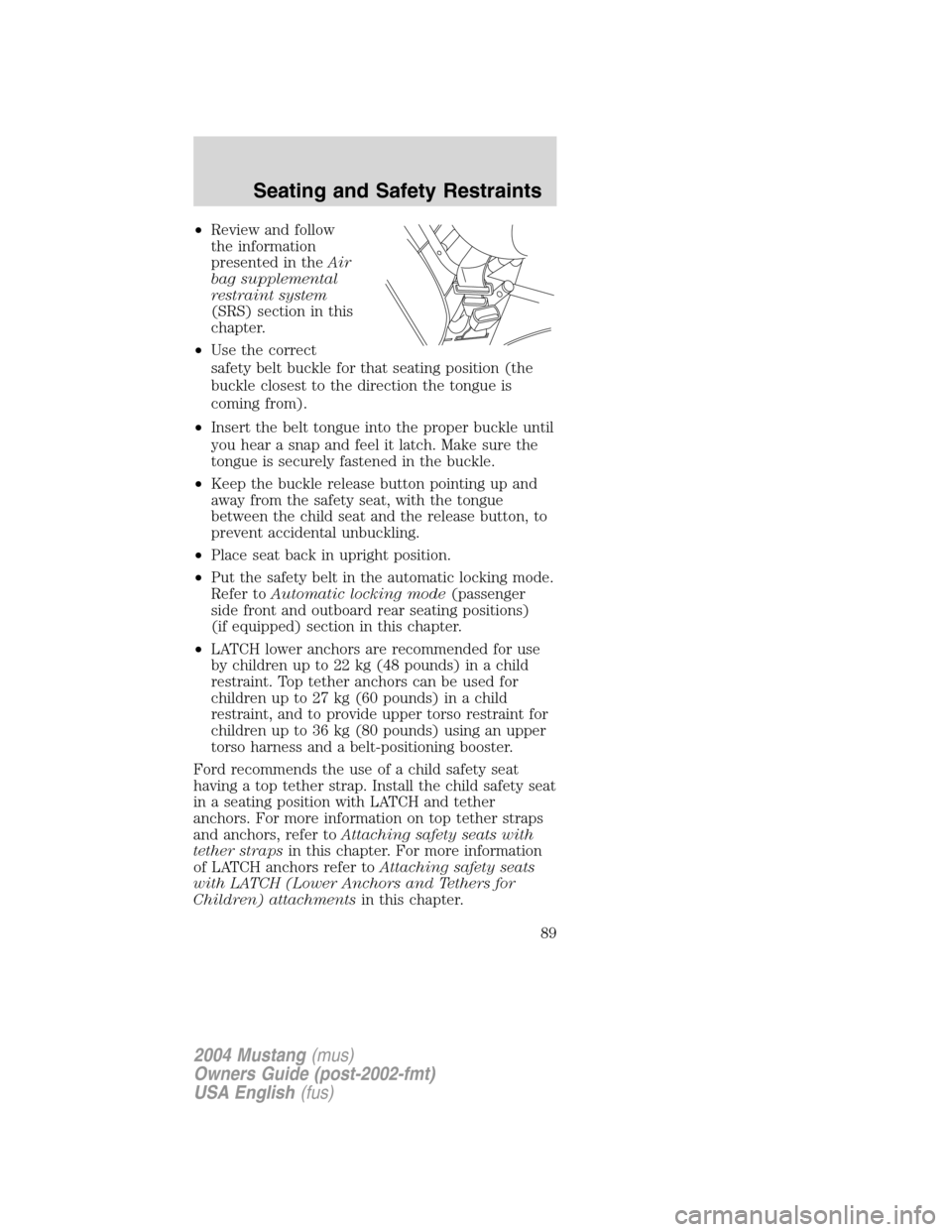
•Review and follow
the information
presented in theAir
bag supplemental
restraint system
(SRS) section in this
chapter.
•Use the correct
safety belt buckle for that seating position (the
buckle closest to the direction the tongue is
coming from).
•Insert the belt tongue into the proper buckle until
you hear a snap and feel it latch. Make sure the
tongue is securely fastened in the buckle.
•Keep the buckle release button pointing up and
away from the safety seat, with the tongue
between the child seat and the release button, to
prevent accidental unbuckling.
•Place seat back in upright position.
•Put the safety belt in the automatic locking mode.
Refer toAutomatic locking mode(passenger
side front and outboard rear seating positions)
(if equipped) section in this chapter.
•LATCH lower anchors are recommended for use
by children up to 22 kg (48 pounds) in a child
restraint. Top tether anchors can be used for
children up to 27 kg (60 pounds) in a child
restraint, and to provide upper torso restraint for
children up to 36 kg (80 pounds) using an upper
torso harness and a belt-positioning booster.
Ford recommends the use of a child safety seat
having a top tether strap. Install the child safety seat
in a seating position with LATCH and tether
anchors. For more information on top tether straps
and anchors, refer toAttaching safety seats with
tether strapsin this chapter. For more information
of LATCH anchors refer toAttaching safety seats
with LATCH (Lower Anchors and Tethers for
Children) attachmentsin this chapter.
2004 Mustang(mus)
Owners Guide (post-2002-fmt)
USA English(fus)
Seating and Safety Restraints
89
Page 90 of 240
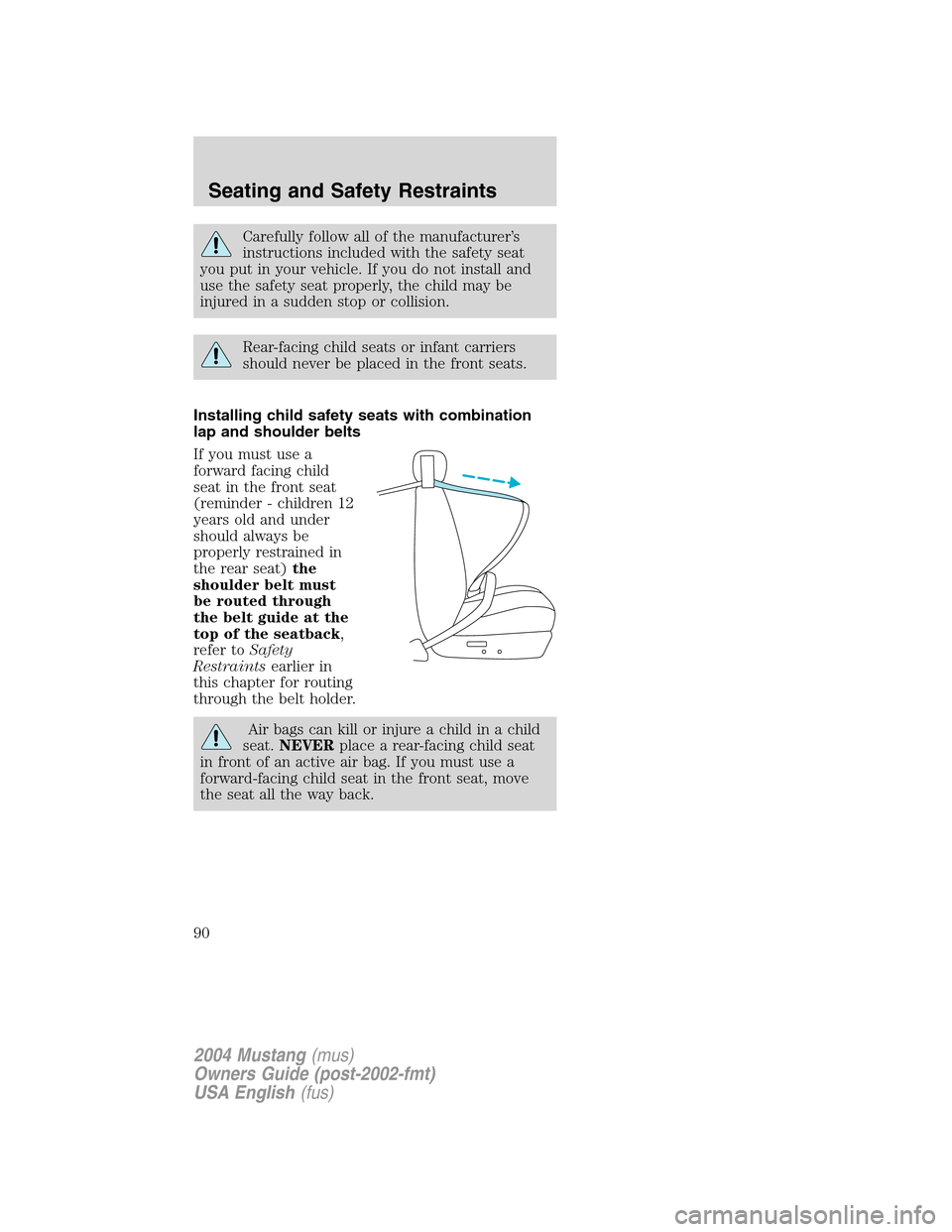
Carefully follow all of the manufacturer’s
instructions included with the safety seat
you put in your vehicle. If you do not install and
use the safety seat properly, the child may be
injured in a sudden stop or collision.
Rear-facing child seats or infant carriers
should never be placed in the front seats.
Installing child safety seats with combination
lap and shoulder belts
If you must use a
forward facing child
seat in the front seat
(reminder - children 12
years old and under
should always be
properly restrained in
the rear seat)the
shoulder belt must
be routed through
the belt guide at the
top of the seatback,
refer toSafety
Restraintsearlier in
this chapter for routing
through the belt holder.
Air bags can kill or injure a child in a child
seat.NEVERplace a rear-facing child seat
in front of an active air bag. If you must use a
forward-facing child seat in the front seat, move
the seat all the way back.
2004 Mustang(mus)
Owners Guide (post-2002-fmt)
USA English(fus)
Seating and Safety Restraints
90
Page 93 of 240
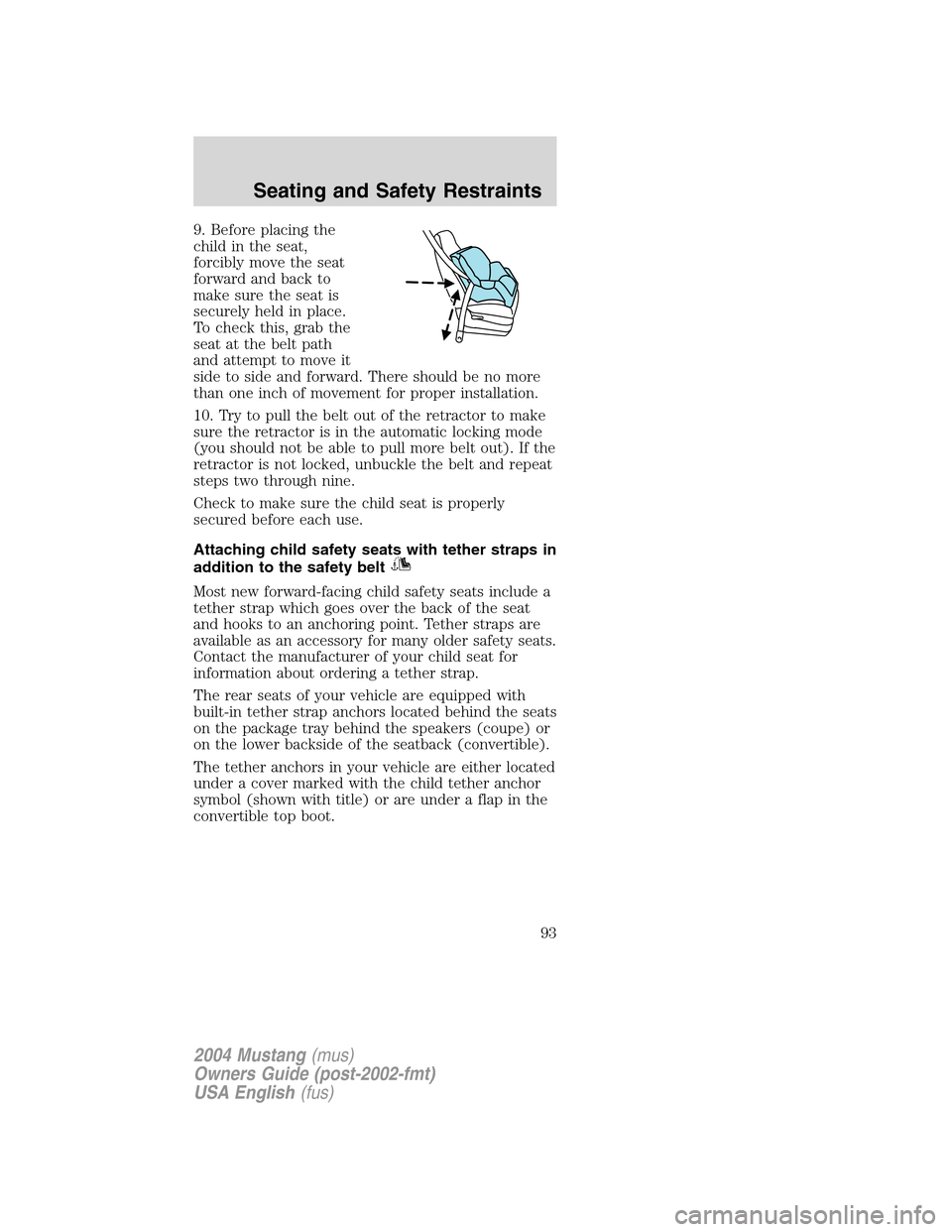
9. Before placing the
child in the seat,
forcibly move the seat
forward and back to
make sure the seat is
securely held in place.
To check this, grab the
seat at the belt path
and attempt to move it
side to side and forward. There should be no more
than one inch of movement for proper installation.
10. Try to pull the belt out of the retractor to make
sure the retractor is in the automatic locking mode
(you should not be able to pull more belt out). If the
retractor is not locked, unbuckle the belt and repeat
steps two through nine.
Check to make sure the child seat is properly
secured before each use.
Attaching child safety seats with tether straps in
addition to the safety belt
Most new forward-facing child safety seats include a
tether strap which goes over the back of the seat
and hooks to an anchoring point. Tether straps are
available as an accessory for many older safety seats.
Contact the manufacturer of your child seat for
information about ordering a tether strap.
The rear seats of your vehicle are equipped with
built-in tether strap anchors located behind the seats
on the package tray behind the speakers (coupe) or
on the lower backside of the seatback (convertible).
The tether anchors in your vehicle are either located
under a cover marked with the child tether anchor
symbol (shown with title) or are under a flap in the
convertible top boot.
2004 Mustang(mus)
Owners Guide (post-2002-fmt)
USA English(fus)
Seating and Safety Restraints
93